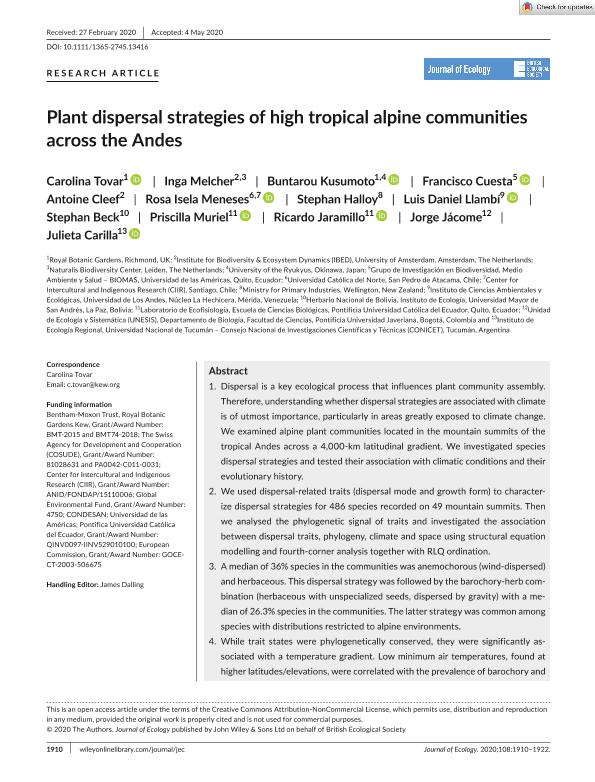Mostrar el registro sencillo del ítem
dc.contributor.author
Tovar, Carolina
dc.contributor.author
Melcher, Inga
dc.contributor.author
Kusumoto, Buntarou
dc.contributor.author
Cuesta, Francisco
dc.contributor.author
Cleef, Antoine
dc.contributor.author
Meneses, Rosa Isela
dc.contributor.author
Halloy, Stephan

dc.contributor.author
Llambi, Luis Daniel
dc.contributor.author
Beck, Stephan G.

dc.contributor.author
Muriel, Priscilla
dc.contributor.author
Jaramillo, Ricardo Luis

dc.contributor.author
Jacome, Jorge
dc.contributor.author
Carilla, Julieta

dc.date.available
2021-11-17T20:25:20Z
dc.date.issued
2020-09
dc.identifier.citation
Tovar, Carolina; Melcher, Inga; Kusumoto, Buntarou; Cuesta, Francisco; Cleef, Antoine; et al.; Plant dispersal strategies of high tropical alpine communities across the Andes; Wiley Blackwell Publishing, Inc; Journal of Ecology; 108; 5; 9-2020; 1910-1922
dc.identifier.issn
0022-0477
dc.identifier.uri
http://hdl.handle.net/11336/147100
dc.description.abstract
Dispersal is a key ecological process that influences plant community assembly. Therefore, understanding whether dispersal strategies are associated with climate is of utmost importance, particularly in areas greatly exposed to climate change. We examined alpine plant communities located in the mountain summits of the tropical Andes across a 4,000-km latitudinal gradient. We investigated species dispersal strategies and tested their association with climatic conditions and their evolutionary history. We used dispersal-related traits (dispersal mode and growth form) to characterize dispersal strategies for 486 species recorded on 49 mountain summits. Then we analysed the phylogenetic signal of traits and investigated the association between dispersal traits, phylogeny, climate and space using structural equation modelling and fourth-corner analysis together with RLQ ordination. A median of 36% species in the communities was anemochorous (wind-dispersed) and herbaceous. This dispersal strategy was followed by the barochory-herb combination (herbaceous with unspecialized seeds, dispersed by gravity) with a median of 26.3% species in the communities. The latter strategy was common among species with distributions restricted to alpine environments. While trait states were phylogenetically conserved, they were significantly associated with a temperature gradient. Low minimum air temperatures, found at higher latitudes/elevations, were correlated with the prevalence of barochory and the herb growth form, traits that are common among Caryophyllales, Brassicaceae and Poaceae. Milder temperatures, found at lower latitudes/elevations, were associated with endozoochorous, shrub species mostly from the Ericaceae family. Anemochorous species were found all along the temperature gradient, possibly due to the success of anemochorous Compositae species in alpine regions. We also found that trait state dominance was more associated with the climatic conditions of the summit than with community phylogenetic structure. Although the evolutionary history of the tropical Andean flora has also shaped dispersal strategies, our results suggest that the environment had a more predominant role. Synthesis. We showed that dispersal-related traits are strongly associated with a gradient of minimum air temperatures in the Andes. Global warming may weaken this key filter at tropical alpine summits, potentially altering community dispersal strategies in this region and thus, plant community structure and composition.
dc.format
application/pdf
dc.language.iso
eng
dc.publisher
Wiley Blackwell Publishing, Inc

dc.rights
info:eu-repo/semantics/openAccess
dc.rights.uri
https://creativecommons.org/licenses/by-nc/2.5/ar/
dc.subject
ALPINE ENVIRONMENTS
dc.subject
DISPERSAL TRAITS
dc.subject
ENVIRONMENTAL FILTERING
dc.subject
FOURTH CORNER
dc.subject
PARAMO
dc.subject
PLANT COMMUNITY
dc.subject
PUNA
dc.subject
RLQ ANALYSIS
dc.subject.classification
Conservación de la Biodiversidad

dc.subject.classification
Ciencias Biológicas

dc.subject.classification
CIENCIAS NATURALES Y EXACTAS

dc.title
Plant dispersal strategies of high tropical alpine communities across the Andes
dc.type
info:eu-repo/semantics/article
dc.type
info:ar-repo/semantics/artículo
dc.type
info:eu-repo/semantics/publishedVersion
dc.date.updated
2021-09-07T14:35:29Z
dc.journal.volume
108
dc.journal.number
5
dc.journal.pagination
1910-1922
dc.journal.pais
Reino Unido

dc.journal.ciudad
Londres
dc.description.fil
Fil: Tovar, Carolina. Royal Botanic Gardens; Reino Unido
dc.description.fil
Fil: Melcher, Inga. University of Amsterdam; Países Bajos
dc.description.fil
Fil: Kusumoto, Buntarou. Royal Botanic Gardens; Reino Unido. University Of The Ryukyus, Okinawa; Japón
dc.description.fil
Fil: Cuesta, Francisco. Universidad de Las Américas.; Ecuador
dc.description.fil
Fil: Cleef, Antoine. University of Amsterdam; Países Bajos
dc.description.fil
Fil: Meneses, Rosa Isela. Universidad Católica del Norte; Chile
dc.description.fil
Fil: Halloy, Stephan. Ministry For Primary Industries; Nueva Zelanda
dc.description.fil
Fil: Llambi, Luis Daniel. Universidad de Los Andes; Venezuela
dc.description.fil
Fil: Beck, Stephan G.. Universidad Mayor de San Andrés; Bolivia
dc.description.fil
Fil: Muriel, Priscilla. Pontificia Universidad Católica del Ecuador; Ecuador
dc.description.fil
Fil: Jaramillo, Ricardo Luis. Pontificia Universidad Católica del Ecuador; Ecuador
dc.description.fil
Fil: Jacome, Jorge. Pontificia Universidad Javeriana; Colombia
dc.description.fil
Fil: Carilla, Julieta. Universidad Nacional de Tucumán. Instituto de Ecología Regional. Consejo Nacional de Investigaciones Científicas y Técnicas. Centro Científico Tecnológico Conicet - Tucumán. Instituto de Ecología Regional; Argentina
dc.journal.title
Journal of Ecology

dc.relation.alternativeid
info:eu-repo/semantics/altIdentifier/url/https://onlinelibrary.wiley.com/doi/abs/10.1111/1365-2745.13416
dc.relation.alternativeid
info:eu-repo/semantics/altIdentifier/doi/http://dx.doi.org/10.1111/1365-2745.13416
Archivos asociados
